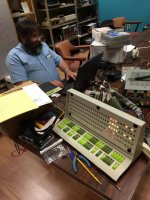Last week we reassembled the PDP-12, reformed the capacitors in the power supply and performed the initial power-on checkout. Nothing caught on fire so we fiddled with the front panel to see if there were any signs of life. The core memory didn't work, and some if the front panel indicators didn't behave as expected. Not unusual for a 43 year old system that has not been powered on for 25 years.
After reading the manual and getting instructions from Warren, we found that some of the misbehaving front panel was due to operator error. The Mode switch to change between LINC and 8 operation doesn't do anything until the I/O Preset switch is pressed. That is working correctly. When you press I/O Preset the INST FIELD is set to 1 and the DATA FIELD is set to 3. I though that this was wrong for an 8k machine. If you look at the
front panel picture you will see three bits for the INST FIELD and DATA FIELD then an additional 2 bits. So part of this is for the 8 and all of it is for the LINC and it is working correctly.
We received lots of comments on reforming the capacitors in the power supply and strong recommendations from experts to just replace them. Since new caps are a different physical size, and would cost about $250 we decided to continue with reforming the originals.
The core memory doesn't work so we measured the ripple on the -30V (the main voltage for the core) on the processor backplane. The ripple was about 800mV, a sign that the caps in the power supply were not working well, and probably too noisy for the core to work.
We started the processor checkout and found that bits 4 and 11 in the Program Counter were always on. We looked at the flip-flops in the processor that make up the PC register and they had the correct contents. We need to determine why the indicator lights on the front panel do not exactly reflect the internal state of the registers in the processor so we can continue debugging.
After running the system for about four hours the ripple on the -30V was down to 180mV, so the capacitors are getting better. More run time will hopefully reduce the ripple to an acceptable level. If not, we will have to replace them.

